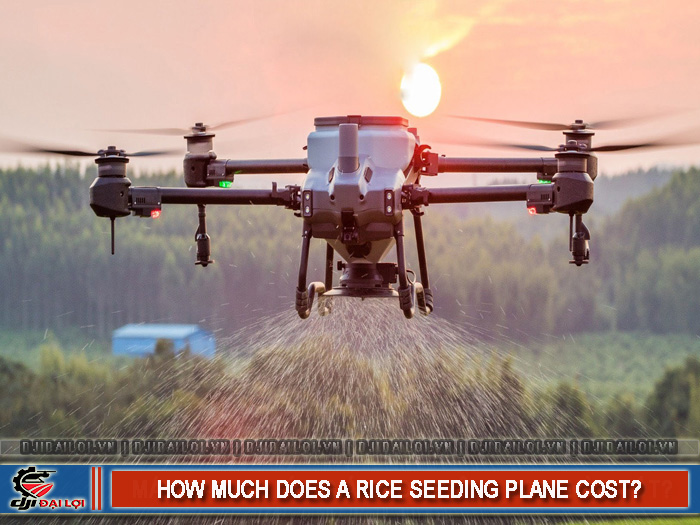
In recent years, rice-sowing drones have become increasingly common in Vietnam, especially in the Mekong Delta and Central regions. However, the question “how much does a rice-sowing drone cost?” remains complex due to a wide price range-from tens to hundreds of millions of dong. In a time of rising production costs, making the right investment at the right scale is critical.
These drones are now a vital part of smart mechanized farming, helping save seeds, reduce labor, and improve productivity. Yet many buyers fail to accurately assess the real value of each model, leading to poor investment choices. Understanding each price segment and choosing the right model helps optimize cost and achieve faster returns.
A rice-sowing drone is not just a flying machine-it’s a system combining GPS, auto-navigation, spreading sensors, payload capacity, and high-capacity lithium batteries. Its price varies mainly based on the following factors:
Common payloads range from 10–25 kg. The higher the payload, the stronger the battery, motor, and frame-thus the higher the cost.
Models with GPS RTK, pre-programmed mapping, and obstacle-avoidance sensors cost more than semi-automatic versions. The more advanced the tech, the higher the sowing precision and efficiency.
|
Model |
Listed price |
Tank & sowing speed |
Sowing efficiency |
Notes |
|---|---|---|---|---|
|
DJI Agras T20P |
~₫219 million |
25 kg; 50 kg/min |
12 ha/hr |
Basic configuration, small–medium farms |
|
DJI Agras T25 |
~₫129 million |
25 kg; 50 kg/min |
12 ha/hr |
Improved tech, larger areas |
|
DJI Agras T25P |
~₫117 million |
35 kg; 75 kg/min |
13.3 ha/hr |
Upgraded sensors and accessories |
|
DJI Agras T40 |
~₫239 million |
50 kg; 70 kg/min |
20 ha/hr |
High-end, optimal performance |
|
DJI Agras T50 |
~₫191 million |
55 kg; 80 kg/min |
24 ha/hr |
Heavy payload, ideal for cooperatives |
|
DJI Agras T70P |
~₫143.7 million |
80 kg; 100 kg/min |
30 ha/hr |
Premium tier, enterprise-level efficiency |
Price tiers:
You can also find locally assembled or used drones under ₫100 million, but check quality, warranty, and long-term reliability carefully before buying.
|
User type |
Recommended budget |
Suggested models |
Why |
|---|---|---|---|
|
Small farms (<5 ha) |
₫100–130 million |
DJI T25P, local models |
Affordable, accurate for small plots |
|
Cooperatives / service providers |
₫150–250 million |
DJI T50, T70P, T40 |
Large payload, RTK GPS, fast ROI |
|
Large-scale farmers |
≥ ₫200 million |
DJI T20P, T30 |
High precision, quick payback |
|
Beginners, low budget (<₫90 million) |
₫70–90 million |
Used DJI T10/T20 or local brands |
Budget-friendly, but inspect carefully |
|
Model |
Hopper capacity |
Key advantage |
Price |
|---|---|---|---|
|
DJI T25P |
35 kg |
Compact, energy-efficient |
~₫117 million |
|
DJI T50 |
55 kg |
High performance, durable |
~₫191 million |
|
TTA 10 kg (Vietnam) |
10 kg |
Low cost, easy to use |
~₫80 million |
ROI insight (from DJI Đại Lợi dealership):
Buy before main seasons (Winter–Spring or Summer–Autumn) to start operating immediately and recoup costs faster.
Avoid buying mid-season or without clear usage plans. Ideally, invest 30–45 days before sowing to train, calibrate, and test the drone properly.
In summary, rice-sowing drones range from ₫80 million to ₫250 million, depending on payload, brand, and features. Models like the DJI T25P and T50 strike the best balance between cost and performance-making them the top choices for Vietnamese farmers preparing for the upcoming crop season.
Yes, if you carefully check the battery, propellers, controller, and purchase record. Expect 30–40% cheaper than new.
Yes, if it operates on high-frequency control (>2.4 GHz) or covers large areas. Notify local authorities if flying over wide zones.
No. Most models are safe only in dry weather with winds under level 4.
At least 2 ha to ensure cost-effectiveness.
Yes. Many modern drones support 3-in-1 functions (sowing, spraying, spreading) with proper nozzle and mode adjustments.